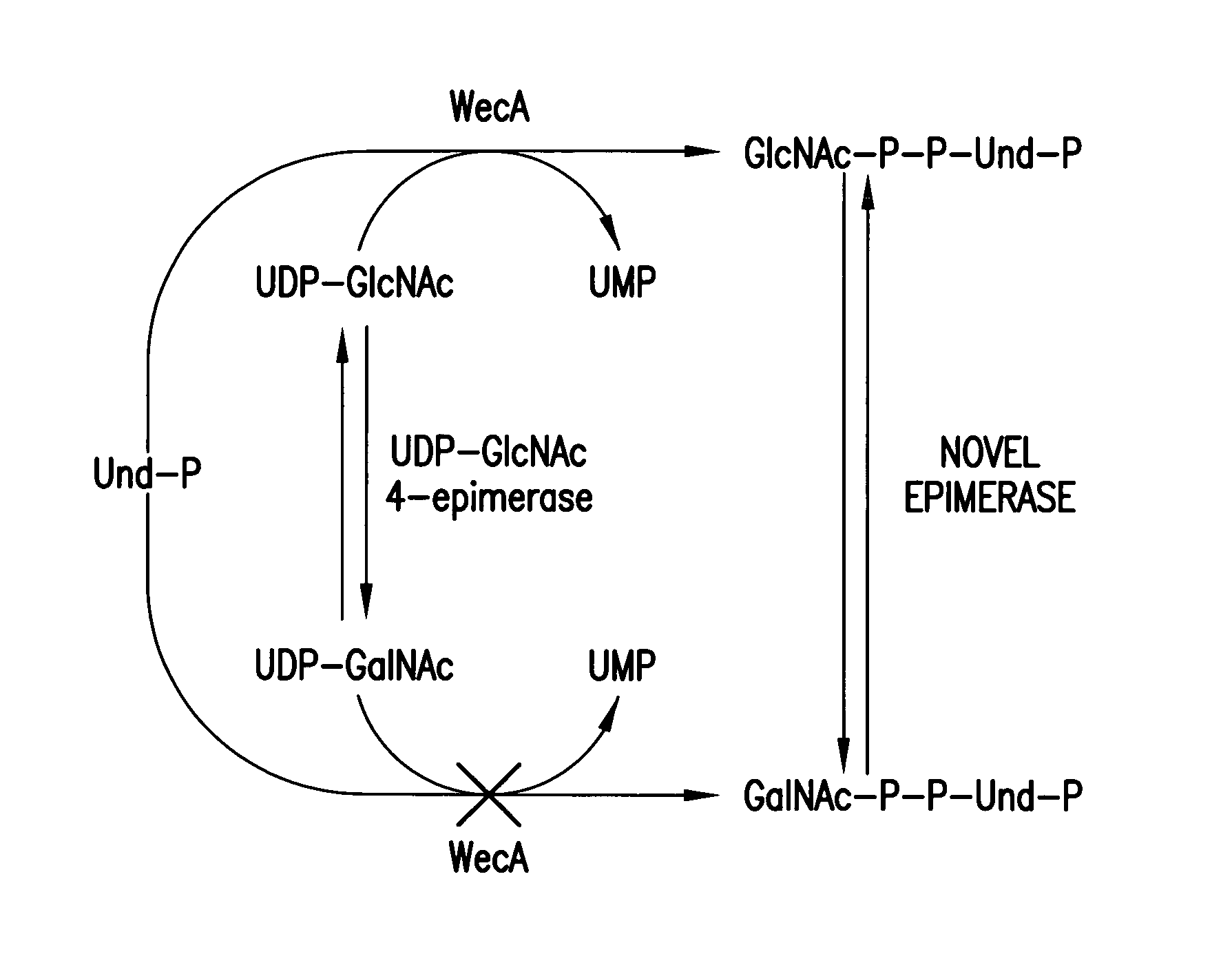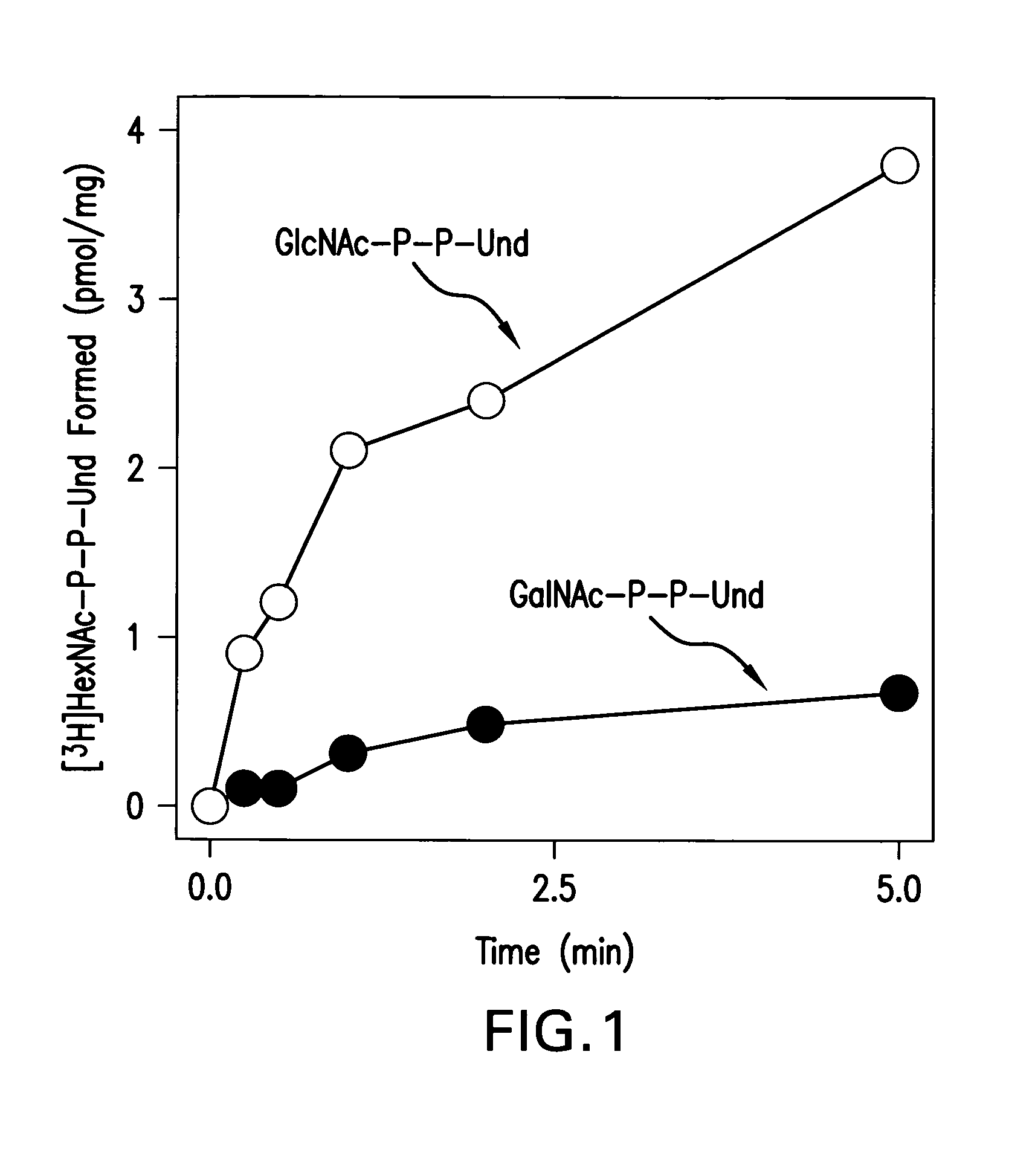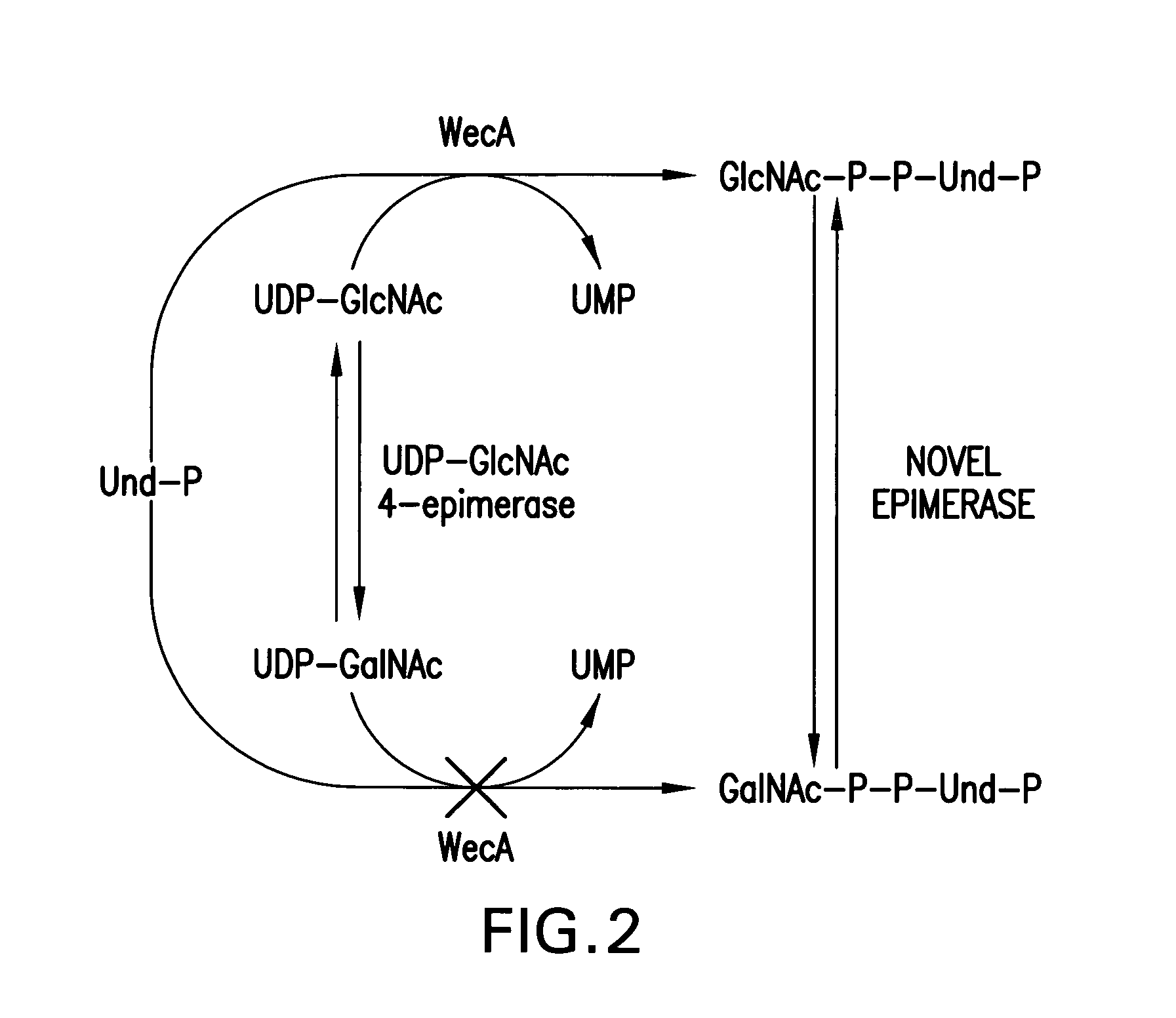Biosynthetic system that produces immunogenic polysaccharides in prokaryotic cells
a biosynthetic system and prokaryotic cell technology, applied in the field of biosynthetic system and proteins, can solve the problems of no direct enzymological evidence, no memory of the immune system,
- Summary
- Abstract
- Description
- Claims
- Application Information
AI Technical Summary
Benefits of technology
Problems solved by technology
Method used
Image
Examples
example 1
Identification of an E. coli O157 Gene Encoding GlcNAc-P-P-Und 4-Epimerase
[0113]We describe herein the surprising discovery of a new biosynthetic pathway in which GalNAc-P-P-Und is formed by the epimerization of the 4-OH of GlcNAc-P-P-Und catalyzed by the previously unknown action of a 4-epimerase. In this pathway, GlcNAc-P-P-Und is formed by the transfer of GlcNAc-P from UDP-GlcNAc, catalyzed by WecA, and then GlcNAc-P-P-Und is epimerized to GalNAc-P-P-Und by GlcNAc-P-P-Und -4-epimerase, which was a previously unknown pathway (FIG. 2).
[0114]The gene encoding a candidate for the GlcNAc-P-P-Und 4-epimerase was identified by DNA homology searches. Homology searches were performed using the U.S. National Library of Medicine databases found at http: / / blast.ncbi.nlm.nih.gov / Blast.cgi. Genomic sequences of different bacteria encoding O antigen repeating units having a GaINAc at the reducing terminus were screened. One group with a repeating unit containing a GalNAc at the reducing terminu...
example 2
UDP-GalNAc is Not a Substrate for E. coli WecA (GlcNAc-phosphotransferase)
[0117]To determine if E. coli WecA will utilize UDP-GalNAc as a GalNAc-P donor to form GalNAc-P-P-Und, membrane fractions from E. coli strains K12, PR4019, a WecA-overexpressing strain, and O157, which synthesize a tetrasaccharide O-antigen repeat unit with GalNAc at the reducing terminus presumably initiated by the synthesis of GalNAc-P-P-Und, were incubated with UDP-[3H]GalNAc.
[0118]Preparation of E. coli membranes—Bacterial cells were collected by centrifugation at 1,000×g for 10 min, washed once in ice-cold phosphate-buffered saline, once with cold water, and once with 10 mM Tris-HCl, pH 7.4, 0.25 M sucrose. The cells were resuspended to a density of ˜200 A600 units / ml in 10 mM Tris-HCl, pH 7.4, 0.25 M sucrose, 10 mM EDTA containing 0.2 mg / ml lysozyme, and incubated at 30° C. for 30 min. Bacterial cells were recovered by centrifugation at 1,000×g for 10 min, quickly resuspended in 40 volumes of ice-cold 10...
example 3
Characterization of [3H]GalNAc-P-P-Und Formed in Vitro with Membrane Fractions from E. coli Strain O157
[0125]Consistent with the additional O157-specific glycolipid product detected in FIG. 1, as GalNAc-P-P-Und, it was stable to mild alkaline methanolysis (toluene / methanol 1:3, containing 0.1 N KOH, 0° C., 60 min), retained by DEAE-cellulose equilibrated in CHCl3 / CH3OH / H2O (10:10:3), and eluted with CHCl3 / CH3OH / H2O (10:10:3) containing 20 mM ammonium acetate as reported previously for [3H]GlcNAc1-2-P-P-Dol (Waechter, C. J. and Harford, J. B. (1977) Arch. Biochem. Biophys. 181, 185-198).
[0126][3H]GalNAc-P-P-Und was clearly resolved from [3H]GlcNAc-P-P-Und by thin layer chromatography on borate-impregnated silica gel G (Kean, E. L. (1966) J. Lipid Res. 7, 449-452) and purified by preparative TLC as shown in FIG. 3A and FIG. 3B.
[0127]Preparation of Borate-impregnated Thin Layer Plates and Whatman No. 1 Paper—Silica gel thin layer plates were impregnated with sodium borate by briefly im...
PUM
| Property | Measurement | Unit |
|---|---|---|
| pH | aaaaa | aaaaa |
| pH | aaaaa | aaaaa |
| density | aaaaa | aaaaa |
Abstract
Description
Claims
Application Information
 Login to View More
Login to View More - R&D
- Intellectual Property
- Life Sciences
- Materials
- Tech Scout
- Unparalleled Data Quality
- Higher Quality Content
- 60% Fewer Hallucinations
Browse by: Latest US Patents, China's latest patents, Technical Efficacy Thesaurus, Application Domain, Technology Topic, Popular Technical Reports.
© 2025 PatSnap. All rights reserved.Legal|Privacy policy|Modern Slavery Act Transparency Statement|Sitemap|About US| Contact US: help@patsnap.com



